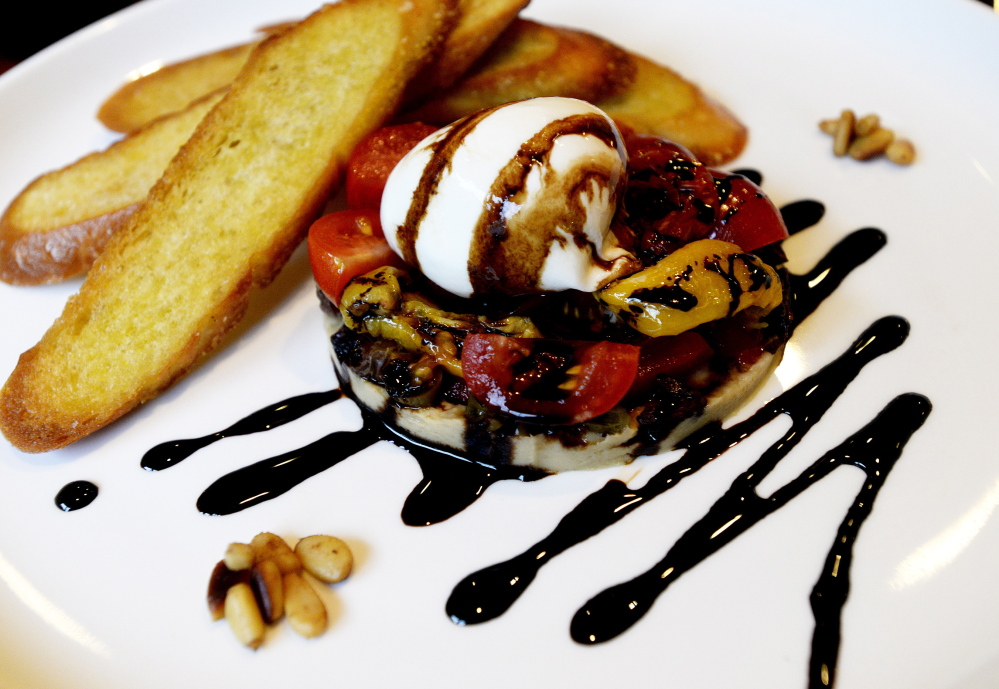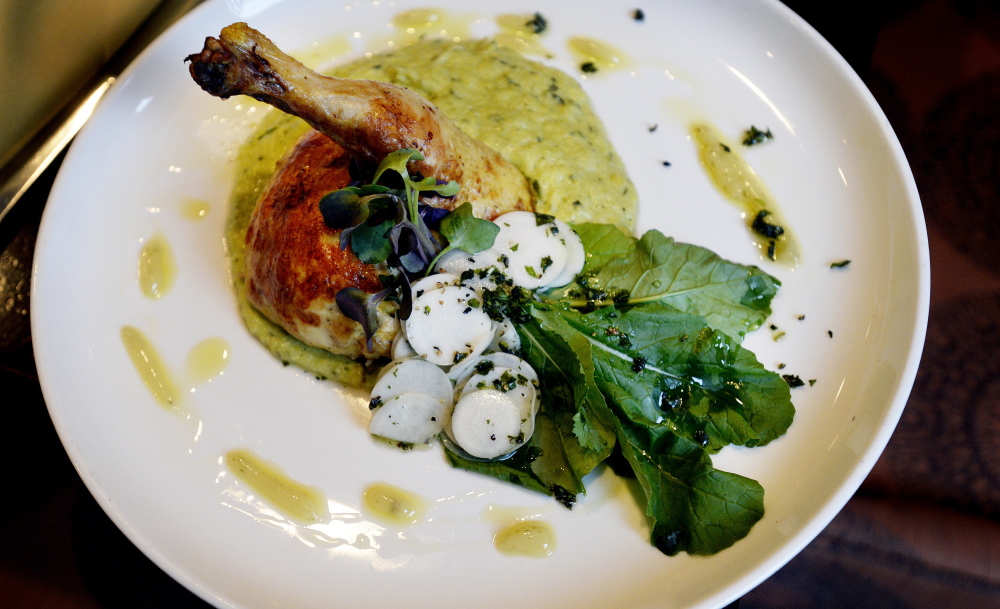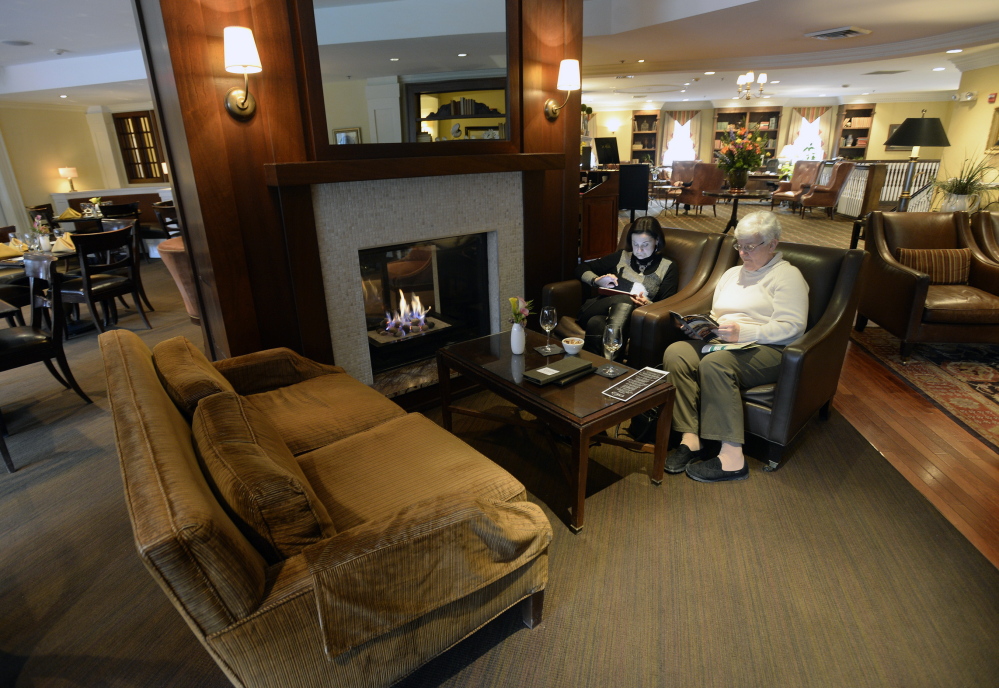Hotel restaurants are the carnations of the dining world. They’re readily available, easily overlooked, usually predictable and – only occasionally – surprising.
Eve’s at the Garden, the small restaurant inside the Portland Harbor Hotel, is all of these. It’s open seven days a week, serving breakfast, lunch and dinner, with happy hour on weekends for good measure. It’s easy to miss, because there’s no sign at street level and the entrance is located one level up near the reception desk off the main lobby. And the food? Pretty much what you’d expect from a hotel restaurant in the heavily touristed Old Port: costly shellfish, pricey steak and a few, more reasonable chicken and vegetarian options. The kitchen has a penchant for gilding the lily with geometric garnishes and sauces squirted extravagantly around plates and platters, but the food itself is often prosaic. (With careful ordering and luck, we did find some good options.)
Take the pickled beet salad starter ($10), a combination of purple and golden beets parading (symmetrically) down a bed of arugula, punctuated by spoonfuls of goat cheese. The waiter told us that the slash of dressing painted next to the arugula was “verjus vinaigrette” (made with juice from unripened grapes). He also noted that what I took for five, perfectly spaced capers were, in fact, “broiled grapes.” Fanciful, yes. Flavorful? Not particularly. The beets were bland and the grapes fell flat. Even the arugula lacked the peppery bite that makes it memorable. This salad seemed all about presentation, and we soon discovered there was more of that to come.
Grilled Romaine ($9), which is making an appearance on menus across town this season, was nicely charred and dressed in a light vinaigrette, but the lettuce was shrouded by copious, overlapping shavings of Manchego cheese and bordered by a rigid array of cornmeal croutons – each topped with a sliver of cherry tomato. The starter looked like a miniature topiary garden, and mowing it down seemed untoward. I had to close my eyes before plunging in. The best appetizer, burrata ($14), arrived with the fewest flourishes: a single pillow of brilliant white cheese served atop cherry tomatoes and olives with a sprinkling of pine nuts. Good burrata is as soft and fragile as a carefully poached egg, and Eve’s version was spot on. The thin skin of the cheese was supple and easily pierced, and the interior revealed the requisite killer combination of fresh cream and silky mozzarella curds. It was a soothing, comforting and pleasingly simple starter.
The entrées we tried at Eve’s mirrored our appetizers. They included a selection of elaborately produced (and pricey) dishes, and a few more modest standouts.
Grilled swordfish ($29), for example, showcased a competently prepared slice of fish, but was served on top of a “toasted cumin risotto” flavored with onions, shallots and garlic, and enriched with crème fraîche. Next to it on the plate were ultra-thin chives, crossed like swords, atop a slice of citrus, plus a green salad that was piled onto spreading fans of melon slices. The individual flavors – and there were plenty – were good, but I wasn’t sure how (or whether) they worked together. Less definitely would have been more.
Almost as ornate were pan-seared sea scallops with green onion relish served on a bed of pancetta-flecked farro and surrounded by a ring of English pea puree. The farro was tasty (it’s tossed in a butter sauce). The scallops were forgettable – and at $33, an expensive letdown.
Much better was the pork rib ($25), a thick chop from Archer Angus in Chesterville that was filled with flavor and – except for the grill marks – virtually unadorned. Eve’s serves the pork next to a tiny canning jar of house-made berry jam that’s sweet and syrupy, along with a few fries made of polenta and garbanzo beans. Though heavy (the corn meal is cooked with cream and butter), they’re a crunchy complement to the juicy chop.
The best entrée was Cornish hen ($26), which is stuffed with a combination of ground chicken and duck, then served with polenta and broccolini. But even here, the kitchen couldn’t leave well enough alone: The hen rose from the plate above a ring of vinaigrette squeezed out like paint from a tube. Still, this meat was impeccably seasoned, skillfully cooked and melt-in-your-mouth tender, with a golden skin that was crisp and salty and downright irresistible.
Executive Chef Anthony St. Peter took over the kitchen here last October, and says he plans to offer seasonal menus and continue showcasing local ingredients. He’s already introduced a collection of new desserts, including one standout surprise: sweet and satisfying panna cotta ($10) that he makes with Maine maple syrup. St. Peter says he prepares the panna cotta with agar-agar, a vegan gelatin alternative, because “it’s important to me that we create dishes here that any of our guests can enjoy, whether they’re vegan or gluten-free.” The dessert is served in another of those miniature canning jars and is topped with a dark chocolate hazelnut ganache. It’s cool and quivering, intensely sweet – and just a bit salty, thanks to a sprinkling of salt over the roasted hazelnuts.
If too many dishes at Eve’s are overproduced, the restaurant itself is understated, quiet and clublike. The staff is courteous (our waiter hurried to close the pocket doors leading out of the dining room when he sensed a draft) and the double-sided fireplace in the center of the room amps up the comfort quotient. There are three booths for larger parties and about 10 smaller tables overlooking a modest courtyard, and if you look carefully you’ll find a statue of Eve in the fountain outside.
Eve’s has a hard time resisting temptation – specifically, the temptation to over-embellish, over-garnish and overdo. For this garden to flourish, some restraint is needed.
James H. Schwartz has covered food, travel and architecture for The Washington Post, Downeast, Coastal Living and Southern Living magazines for more than 30 years. Long a commuter between Portland and Washington, D.C., he retired from his job as vice president at the National Trust for Historic Preservation in 2013 and relocated to Maine.
Send questions/comments to the editors.




